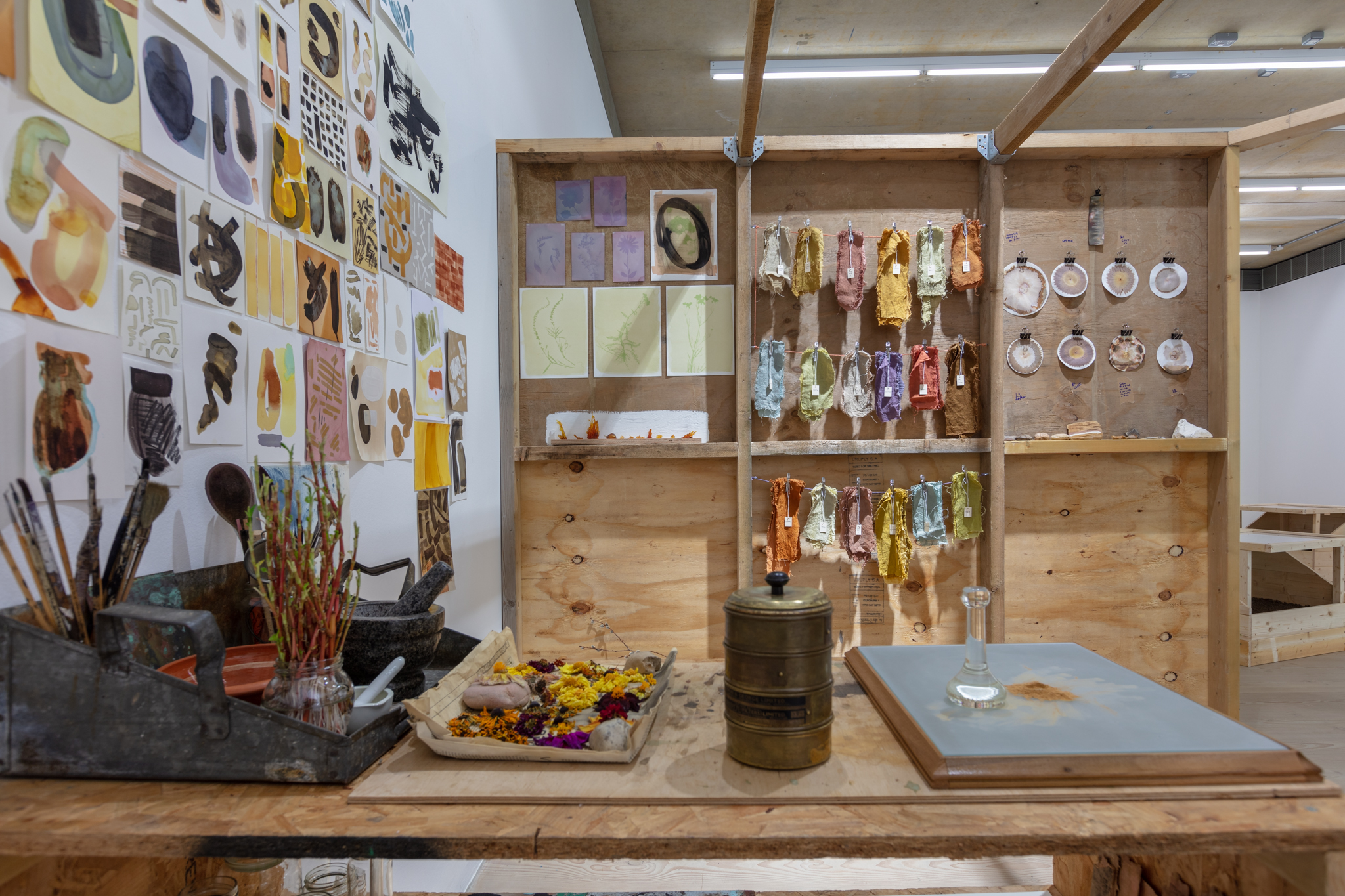


Southend Central is a mere 54 minutes from Fenchurch Street Station, but with the dearth of travel out of London over the past 19 months a daytrip to this Essex resort on the Thames Estuary offers a refreshing change of scenery. Especially on a sunny day, such as the one in late September when I visited the latest exhibition at Focal Point Gallery, The Tip of the Iceberg, which explores why and how horticulture might constitute a radical form of praxis.
A mural drawn with adhesive tape, by Kathrin Böhm, succinctly introduces the idea of the ‘iceberg economy’ put forward by feminist geographers J.K. Gibson-Graham (Julie Graham and Katherine Gibson) in their 2006 book A Postcapitalist Politics. In this model, capitalist strategies form the visible tip of an iceberg that is otherwise constituted of informal, collective actions that support and are routinely exploited by the capitalist system. These include economies of gift and care, community and mutual support, foraging, growing and bartering: vital practices exposed by the current pandemic, but still widely undervalued in our profit-driven societies. But the picture is not entirely bleak, nor is this icebergian set-up the only way to do things. As Böhm’s mural explains, in what might be taken as a mission statement for the exhibition: what lies “below the surface, instead of sustaining mechanisms of [its] own alienation, can be expressed to fuel systemic transformation.”
Graham Burnett’s vast charcoal wall drawing of a tree is divided in half along the horizon, giving equal space to roots and branches to visualise the importance of both abstract principles and concrete action. The subterranean portion of the tree is annotated with axioms relating to sustainability, such as ‘integrate, don’t segregate’ and ‘care for the future’. Above ground, the branches are festooned with the names of local organisations espousing those same values: ‘Southend Youth Council’, ‘Incredible Edible Leigh-on-Sea’. In an invitation for us all to view our worlds in a similar way, unannotated copies of the drawing are available for visitors to fill in with their own ideas.
The exhibition invites further action with Australian artist Gabriella Hirst’s Sub Rosa, a plant-grafting workshop that doubles as a deep-dive into 20th century horticulture and geopolitics. It is part of Hirst’s ongoing project How to Make a Bomb, for which she salvaged a near-extinct species of rose named ‘Atom Bomb’ developed in the 1950s to celebrate nuclear technology. Hirst is propagating the flower and planting new specimens across the country as a means to discuss British nuclear and colonial history. The hybrids grafted in September now sit outside the gallery awaiting new homes in public and private gardens. Described by plant historian Andreas Barlage as having a colour that ‘should strike the eye like an atomic flash’, the roses will grow in acknowledgement of the transportation of British nuclear weapons to Australia and their detonation on Indigenous lands at Maralinga, Emu Field and Monte Bello in the 1950s and 60s, as part of what Hirst refers to as ‘the Imperial programme of gardening the world’.
Uriel Orlow’s Geraniums are never red explores a specific instance of human-forced migration of plants, through an ongoing collection of images of pelargoniums planted in public gardens around Europe. The work is presented here as billboard-sized images of Swiss and Californian coastal scenes featuring what are commonly called geraniums, and a rack of free picture postcards with scenes from around the world – including Southend-on-Sea’s seafront – all of which feature the classic scarlet variety.
Pelargoniums, which were first brought back to Europe from South Africa in the 17th century by the Dutch East India Company, have long been misidentified as geraniums, but are in fact a separate species. These misidentified ‘African geraniums’ stand for the way plants become ‘naturalised’, their true origins and journeys across time and space have been nullified by more powerful cultural and commercial identifications, and sentimental claims to tradition and ownership.
Other works involve active use of plants, such as Anna Lukala’s shed-cum-workshop installation, in which she produces dyes from plants and minerals foraged and found around Southend. A plethora of source materials and notes, pigment samples and grinding surfaces, are evidence of deep and ongoing research. This intriguing studio laboratory occupies a corner of the gallery, where it gives off an alchemical energy, as though the artist has just stepped out to fetch more supplies to advance a thrilling discovery.
The politics of local growth is at the heart of Shaun C. Badham’s installation PLOT: The Peoples’ Landscapes, part of an ongoing project around the history of the Essex Plotlands, areas composed of parcels of land that were sold – often to East Londoners – for family-built settlements from the late 19th century to WWII. Noting similarities between the plotlands and present-day allotments, the work comprises five hand-drawn maps of allotment sites in the Southend area annotated with the initials of current occupants and the year they arrived and presented in cold frames, filled with soil from each location.
Badham garners new information for the maps through conversations with allotmenteers, a lengthy process that develops piecemeal, following its own temporality like the phases of gardening. At the end of the exhibition each cold frame will be given to the relevant allotment to serve for cultivation and over time the maps will be filled in with missing information. As gardeners continue to form new relationships with each other and share seedlings, and as knowledge about the particulars of land usage grows, the project also provides detailed evidence for the case against a constant threat to its very existence: acquisitive property developers operating in the faraway tip of the iceberg.
Ellen Mara De Wachter is a writer and yoga teacher based in London. From 2013-2015 she was the Contemporary Art Society’s Curator of Public Collection Development.
Focal Point Gallery, The Forum, Elmer Square, Southend-on-Sea SS1 1NB. Open Wednesday to Saturday, 11.00–17.00, Sunday, 11.00–16.00. Exhibition continues until 9 January 2022. www.fpg.org.uk